Disneyland Park has experienced its ups and downs when it comes to attractions throughout the years. When looking back, one of the most prominent failed projects, Rocket Rods, sits pretty close to the top.
Problems of Tomorrow
Rocket Rods was the new anchor attraction for Disneyland’s infamous Tomorrowland relaunch in 1998. The 1998 update was the first real update since 1967, with Space Mountain, Captain EO, and Star Tours all being significant additions in the time between. The 1998 update of Tomorrowland had been in design for six years, going through several concepts, most notably Tomorrowland 2055. Coming off the heels of Euro Disney’s opening in Paris, Imagineers looked at both domestic parks’ Tomorrowlands as areas in need of attention. Magic Kingdom’s 1994 Tomorrowland took a different direction in tone and theme; however, it received two attractions that were either reused from Disneyland Paris or meant for Disneyland’s Tomorrowland 2055 (Timekeeper and Alien Encounter.)
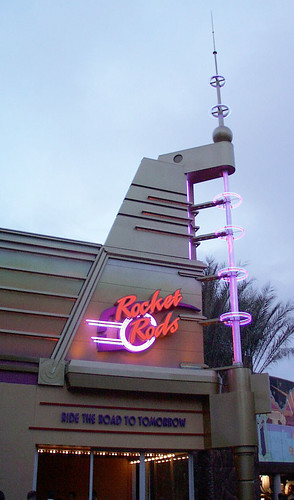
By the time Tomorrowland’s construction had started, many show facilities had already been closed. The Carousel building was closed in 1988, Mission to Mars in 1992, and the Skyway and Peoplemover in 1995. This leads us to Rocket Rods, which opened on May 22, 1998.
The Team’s Plan
As Walt Disney World’s updated Tomorrowland opened and Test Track’s original installation continued to be delayed at Epcot, Tony Baxter and the Imagineering team continued to find their Disneyland Tomorrowland project getting pushed to the back burner. While this did influence their visions, the project did have some issues of its own. Removing the Rocket Jets attraction on top of the Peoplemover platform in 1997 and installing a new Euro Disney-inspired Astro Orbiter ride system at the front of the land by the Central Plaza is one of them. Other issues include rebuilding the entire Carousel Building, introducing an additional restaurant at Mission to Mars, and repainting the land bronze (including all of Space Mountain). These were all deemed to be unnecessary expenses.
Meanwhile, they found ways to skimp on costs. Examples include reusing the Tomorrowland Theater (which previously showed Captain EO) for Honey I Shrunk the Audience, turning the Circle-Vision 360 theater into the Rocket Rods queue, and adapting the already problematic Test Track ride system by placing it on the existing Peoplemover support structure. Ironically, a Tomorrowland update inspired by Imagineering’s recent work in Europe ended up being one of the many reasons for Disneyland Paris’ financial failures. General Motors was originally going to be the sponsor of the new attraction, but decided against it.
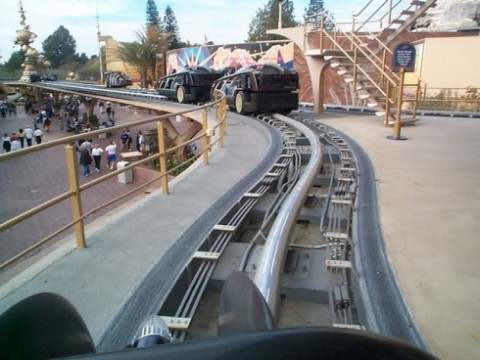
The Inevitable Result
The result for Rocket Rods was a ride system that was too heavy for the Peoplemover track, too slow of a ride for thrill-seekers, too fast of a journey for guests who enjoyed the Peoplemover, and far too low capacity. This made the pre-FastPass 75-120 minute wait times not worth it. It was also tricky having a system like this to run reliably as the land’s new anchor attraction. The ride vehicles had four rows, singular seats in the first three rows, and then two seats in the last row. They simply did not hold enough guests. To make things worse, when Rocket Rods opened, Disneyland shut down the two of the three remaining Tomorrowland attractions that had not seen any updates; Submarine Voyage and Autopia. Within six weeks of its grand opening, Rocket Rods had to be shut down for maintenance. This was right after the Fourth of July in 1998, during the height of the summer season. With Submarine Voyage and Autopia both closed, park guests were frustrated with the “updated, fresh Tomorrowland.” Disney had marketed something completely different.
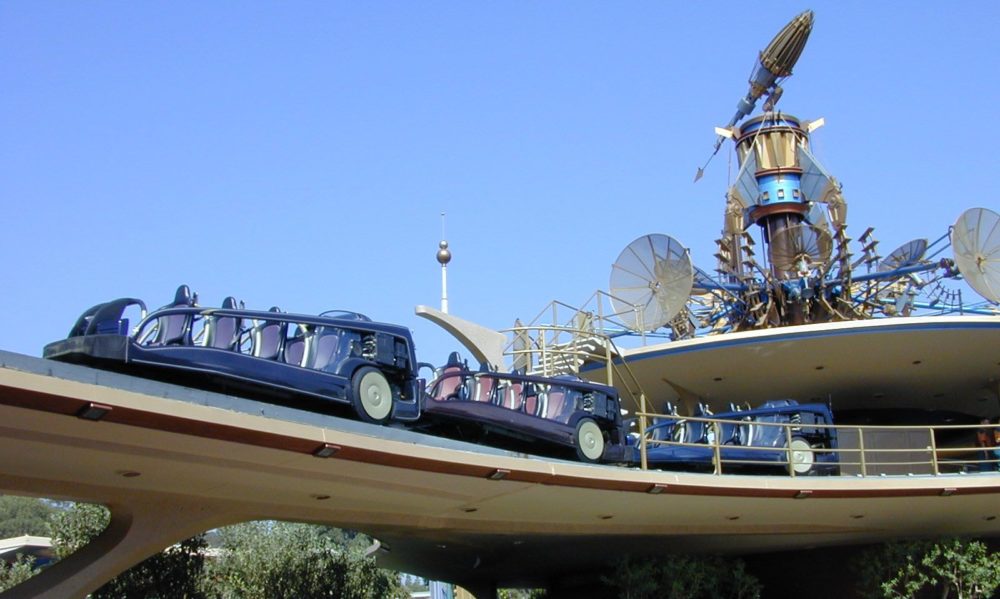
While the crowd levels were lower than modern-day Disneyland, this period of Disneyland’s history was right when facilities were being shut down throughout the park, and outdoor vending carts were growing in numbers. This resulted in crowding the once-intimate Disneyland paths. Having two high-capacity Disneyland attractions (Circle-Vision 360 and Peoplemover) combined into one low-capacity attraction experience was not the wisest decision, but one that followed management’s logic in the late ’90s. There were, however, attempts to make Tomorrowland feel more substantial and spacious. Another example of where the Tomorrowland 1998 budget went was removing the entrance speed ramps from both Space Mountain and the Peoplemover platform, in addition to the platform’s exterior elevator. The idea was that this would free up space in the Tomorrowland plaza for gardens with plants. These bright plants resembled edible food. A water splash pad was also added, which was marketed as an attraction, Cosmic Waves.
All Good Things Come to Those “Queue” Wait
A new costly tunnel was dug and installed alongside an existing tunnel system. It ran between the Carousel building complex and Tomorrowland Terrace to help bring people between the Circlevision building and the Rocket Rods tower.
Guests would take this tunnel to load and unloading, back to where the gift shop to Buzz Lightyear Astro Blasters is today. In both Circle-Vision 360’s old pre-show room and its main theater, guests waiting in the queue could watch compilations of old Disney-produced animated segments and old Circle-Vision 360 videos. These emphasized that the Rocket Rods attraction was the combination of all the futurist thinking from the ’50s until now. Charming clips of Walt introducing the segments played. Old Disneyland ride vehicles and a map showing future Rocket Rods terminals throughout Orange County were present. This all helped tie the new attraction into Disneyland’s culture. Guests could also see through the old Peoplemover windows, which gave a glance of the rockets.
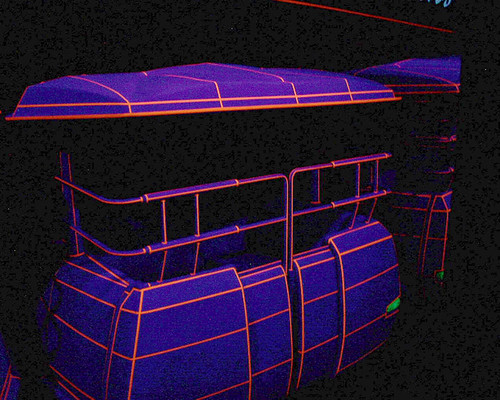
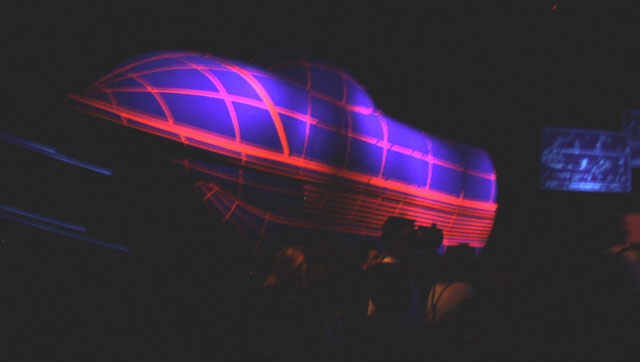
Rocket Rods would follow the original Peoplemover layout, zipping through the same buildings and the Autopia area. Leaving the 2nd floor of the Carousel building allowed for its fastest stretch of track. The second floor, as well as an expansion towards the old skyway platform, also served as a new maintenance facility for the ride vehicles. Space Mountain at Walt Disney World has this for their Peoplemover.
End in Need is an End Indeed
In September 2000, Rocket Rods shut down for the last time. Promises were made in the press that it would return in 2001 with improvements in time for the expected crowds for the opening of Disney California Adventure Park in February of 2001. By April of 2001, California Adventure opened and was already under severe pressure itself. The President of the Disneyland Resort, Cynthia Harriss, actually admitted that the attraction was a failure. She stated that it never met operational standards and was not returning. This announcement was not a massive surprise to the Disney community at the time. New visitors saw one of the ride vehicles placed in Disney California Adventure’s Hollywood backlot as a prop. Two years later, the ’90s Imagineering product, Superstar Limo, would soon join it in the graveyard.
Most of the ride vehicles were destroyed by Disney. Fittingly, the ride system was eventually stabilized, and the third version of it opened in 2001 at Tokyo DisneySea’s Journey to the Center of the Earth. Then again, ironically at Disney California Adventure as Radiator Springs Racers in 2012.
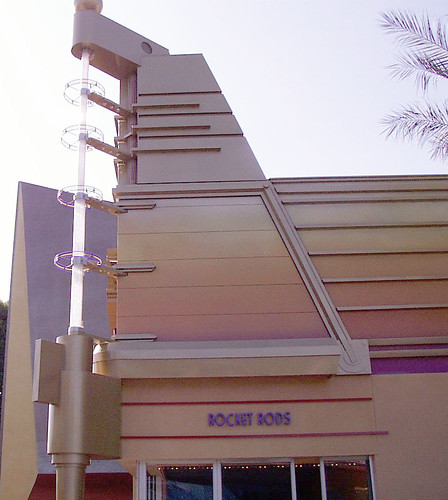
While this attraction was not everything we hoped for, it will always remain as a piece of Disneyland history. To this day, Tomorrowland continues to evolve, but the track still sits empty and reminds us of its past. Hopefully one day, we can see this space utilized correctly again. Until then, let’s hope for a better and brighter tomorrow.


